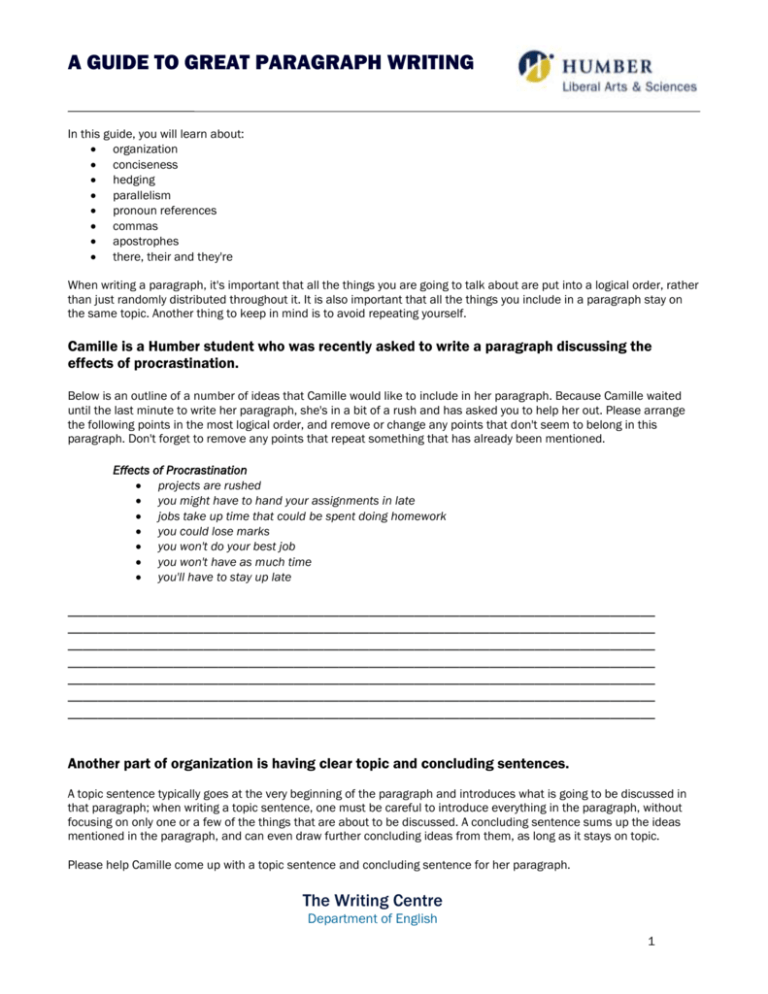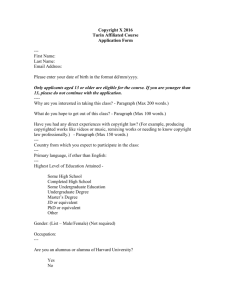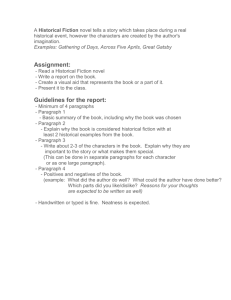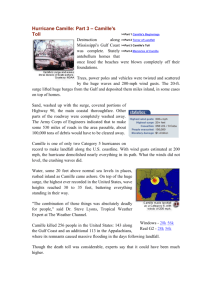A GUIDE TO GREAT PARAGRAPH WRITING In this guide, you will
advertisement

A GUIDE TO GREAT PARAGRAPH WRITING In this guide, you will learn about: organization conciseness hedging parallelism pronoun references commas apostrophes there, their and they're When writing a paragraph, it's important that all the things you are going to talk about are put into a logical order, rather than just randomly distributed throughout it. It is also important that all the things you include in a paragraph stay on the same topic. Another thing to keep in mind is to avoid repeating yourself. Camille is a Humber student who was recently asked to write a paragraph discussing the effects of procrastination. Below is an outline of a number of ideas that Camille would like to include in her paragraph. Because Camille waited until the last minute to write her paragraph, she's in a bit of a rush and has asked you to help her out. Please arrange the following points in the most logical order, and remove or change any points that don't seem to belong in this paragraph. Don't forget to remove any points that repeat something that has already been mentioned. Effects of Procrastination projects are rushed you might have to hand your assignments in late jobs take up time that could be spent doing homework you could lose marks you won't do your best job you won't have as much time you'll have to stay up late ______________________________________________________________________________ ______________________________________________________________________________ ______________________________________________________________________________ ______________________________________________________________________________ ______________________________________________________________________________ ______________________________________________________________________________ ______________________________________________________________________________ Another part of organization is having clear topic and concluding sentences. A topic sentence typically goes at the very beginning of the paragraph and introduces what is going to be discussed in that paragraph; when writing a topic sentence, one must be careful to introduce everything in the paragraph, without focusing on only one or a few of the things that are about to be discussed. A concluding sentence sums up the ideas mentioned in the paragraph, and can even draw further concluding ideas from them, as long as it stays on topic. Please help Camille come up with a topic sentence and concluding sentence for her paragraph. The Writing Centre Department of English 1 A GUIDE TO GREAT PARAGRAPH WRITING A concise paper says what you want in as few words as possible. Camille has received a paragraph back from her teacher and has been asked to revise it. Her teacher told her that her paragraph is not very concise. Because Camille is still learning how to write concisely, she has asked for your help once again. Here are some ways to be concise in your writing: Find wordy portions of text and revise them in order to say the same thing using less words. Take out any repetitive words or phrases. Remove anything that doesn't really go with the topic. Avoid being too “fluffy” or too specific when using examples. Take out any other words that really aren't necessary. Below is Camille's paragraph. Please revise it to make it more concise. Going to a cottage is very similar to camping in a tent, but there are also some major differences as well. Going to a cottage is a lot of fun. Camping is fun, too. When you go on a vacation to a cottage, you get to sleep in a permanent and solid building. If you decide to go camping instead, however, you will have to sleep in a tent, or sometimes in a trailer. When you are sleeping, at night, in a cottage, sometimes you may encounter mosquitos and other pesky bugs such as flies or spiders or ants, but as long as the window and door screens are in good condition and there are no cracks in the building, there shouldn't be too many of them, at least. During when you are camping, though, because you are outside and not in a building, there's more of a chance of encountering mosquitos, flies, spiders, ants and other bugs. If it rains when you are staying at a cottage, it's alright because there's a roof over your head, or if you're outside you can go inside and avoid getting wet. When you're camping, however, unless your tent is weather-proofed, rain could get inside of your tent and get you wet, and even if it is weather-proofed, you're sure to feel cold and damp, anyways. For example, if there is a thunder storm, you will need to find shelter, and cottages are safer than tents in a thunder storm. So, even though both experiences are fun and enjoyable, cottages are more like being at home, only in a new place, and camping is more of an adventure: roughing it in the wild. Hedging...what in the world is that? Hedging is something you need to do to a sentence that assumes too much (or too little) about something. Here is an example: Original: Everyone loves Facebook. Hedged version: Many people love Facebook. See? The second sentence is more accurate than the first. Here's a way to remember this strange term, “hedging.” Imagine that your sentences are hedges. When they are a little too tall, trim them down a bit (or add to them if they're too short). Here is another example of hedging: Original: People smoke to relieve stress. Hedged version #1: One reason people smoke is to relieve stress. The Writing Centre Department of English 2 A GUIDE TO GREAT PARAGRAPH WRITING Hedged version #2: Some people smoke to relieve stress. Parallelism is used to make sure that parts of a sentence, or items in a list, are written in the same format. When there is a list of items in a sentence, one good way to make sure they are parallel is to make sure that each item follows from the beginning of the sentence. In order to do this, you first need to identify each separate item in the list. Consider the following sentence: In order to stay healthy, people should eat lots of fruits and vegetables, avoid too much sugar, and exercise regularly. It's easiest to find your second item first, and match it up with the beginning of your sentence. In order to stay healthy, people should eat lots of fruits and vegetables, avoid too much sugar, and exercise regularly. (Notice how “In order to stay healthy, people should avoid too much sugar” makes a complete sentence. This is how you can determine what the introduction of a list is.) The part in between the beginning of your sentence and your second item is your first item. In order to stay healthy, people should eat lots of fruits and vegetables, avoid too much sugar, and exercise regularly. After this, you can identify any others items as well. In order to stay healthy, people should eat lots of fruits and vegetables, avoid too much sugar, and exercise regularly. Next, put each of these separate parts of your sentence on a separate line. In order to stay healthy, people should eat lots of fruits and vegetables avoid too much sugar exercise regularly Now, read the beginning of the sentence followed by the first item. Then read the beginning of the sentence followed by the second item. Continue doing this for each item, making sure that every time you read it, the two pieces put together make a full sentence. Be sure to change an item if it doesn't complete the thought. Next, for both lists and any other parts of sentences, in order to make these parts even more parallel, you need to make sure the words are in the same format. Notice the next example about two things that Camille enjoys: Camille enjoys eating ice cream and goes for walks with her dog. NOT PARALLEL. Camille enjoys eating ice cream and going for walks with her dog. THAT'S BETTER. If one part of a sentence has an “-ing” verb plus a noun, the other items should be the same. Or if part of another list has an adjective plus a noun, the others should be the same, as well. It's up to you to decide which format would work best. They can be hard to find, even when you look for them. The Writing Centre Department of English 3 A GUIDE TO GREAT PARAGRAPH WRITING Wait a second…who exactly are they? What about them? Look at this improved version of the above sentence: Antecedents can be hard to find, even when you look for them. That second version was clearer. Now, what are antecedents? Antecedents are the words that pronouns, such as “they,” “them,” or “it,” refer to. When writing, you must be careful that when you use pronouns, you are able to easily identify exactly what the antecedent of each pronoun is. Consider the following example: Camille spent hours on her painting, and now it looks beautiful. In the above sentence, her is a pronoun, and Camille is its antecedent. It is another pronoun, and painting is its antecedent. Note: It's a good idea in formal writing to avoid using more personal pronouns such as “I” or “we” or “you.” Instead, stick to using pronouns such as “he/she/it” and “they.” Commas Commas should be used in between items in a list before a FANBOYS word (for, and, nor, but, or, yet and so) after the introduction word or phrase of a sentence surrounding a phrase containing extra information Here are some examples of how commas are used: I like apples, pears, strawberries and grapes. I am running out of fruit, so I must go buy some more. After I buy some fruit, I will make a fruit salad. Tonight, when I have some friends over, we will eat the fruit salad. Note: When using a comma after an introduction word or phrase, or to separate a phrase containing extra information, read what's left of the sentence (not including those parts you've separated with commas) to make sure that what's left is a complete sentence. If not, you may have put a comma in the wrong place, or you may need to reword part of the sentence. Another note: In a list, a comma is not always necessary before the 'and' separating the last two items. Camille has recieved an e-mail from one of her friends. The only problem is that it has absolutely no commas in it! It's a tad confusing, so she's wondering if you could help her understand the e-mail. Please insert commas wherever they are needed. Dear Camille As you probably know our group project is due next Friday. I have talked to the other members and they are all confused about what they're working on so we've agreed that we need to have a meeting. We could meet either Monday Wednesday or Thursday but Sunday and Tuesday will not work because I am busy those days. At our meeting after we go over what we've accomplished so far we need to clearly assign different The Writing Centre Department of English 4 A GUIDE TO GREAT PARAGRAPH WRITING parts of our project to each member. Nobody understands the second question on the assignment sheet about scheduling an interview so I am going to e-mail our teacher tonight. We should have our meeting as soon as possible in order to give us enough time to finish our project so please let me know if you are available to meet on Monday. Thanks! Apostrophes Apostrophes are used with possessive nouns and contractions. Below are some examples of how apostrophes show possession. In the following sentence, one person owns a goldfish. This is my brother's goldfish. In the next sentence, more than one person owns a goldfish. This is my brothers' goldfish. In this last sentence, there's more than one person, but they don't own anything here. I have seven brothers. Sometimes it's a little less obvious whether or not to use an apostrophe. Notice the next sentence. Camille's favourite giraffe lives at the African Lion Safari. Whose favourite giraffe is it? Camille's. One exception to this rule is its/it's. For it, the rule is reversed. Its, with no apostrophe, is possessive. It's means “it is.” One way to remember this rule is to imagine that the apostrophe divides it's into two separate words: “it” and “is.” Note: For irregular words such as children, the possessive form is children's, not childrens'. The other use for apostrophes is in contractions. A contraction is a single word made up of more than one word (or, in some cases, a shortened version of a single word). Below are some examples of contractions: did + not = didn't let + us = let's Notice that the apostrophe is used in place of a missing letter or letters. The Writing Centre Department of English 5 A GUIDE TO GREAT PARAGRAPH WRITING There, their and they’re “There” usually refers to a place, either literally or figuratively. “Their” is possessive. “They're” means “they are.” In the following paragraph, fill in all the blanks with “there,” “their” or “they're.” Once upon a time, _______ lived three dragons. _______ was an orange dragon, a lime-green dragon, and an ochre dragon. _______ home was a giant underground cave. _______ hobbies included hunting for treasure and kidnapping princesses who wear paper bag dresses. One day, the dragons were all sitting around, counting _______ trinkets, when _______ was a loud thump on the ground above them. The orange dragon was curious, and went to see what the noise was. Two seconds later, he flew back into the cave and yelled, “_______ coming! Run away!” The other two dragons attempted to pick up all _______ trinkets and carry them out the back exit. The orange dragon just kept going as fast as he could. Soon, _______ was a loud thundering noise coming from the front entrance of _______ cave. It grew louder and louder. Suddenly, a hurd of elephants came bursting into the cavern, squashing all the treasures and snorting as loud as _______ trunks would let them. The elephants ran out the back exit and found the three dragons attempting to hide behind some trees growing _______. The elephants knocked over the trees and chased the dragons all the way to Japan. Do not ask me how they got across the ocean. After _______ adventure, the elephants were tired and they all fell asleep. The dragons decided to fly back to _______ home, but they got lost on the way (_______ directionally-challenged dragons), so they decided to retire and live at a resort in California. The end! The Writing Centre Department of English 6








